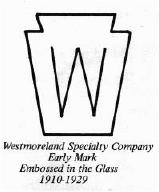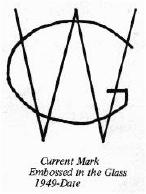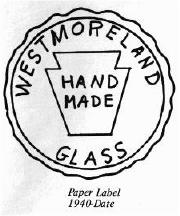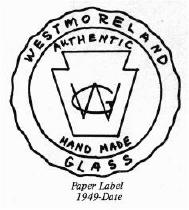National Depression Glass Association
Preserving America's Glass Manufacturing Heritage
Westmoreland Glass Company
by Joseph D. Lokay
Rainbow Review Glass Journal - May 1977
The Westmoreland Glass Company was founded In 1889. Early in that
year, the directors of the Specialty Glass Company of East Liverpool,
Ohio, decided to move their plant from East Liverpool to Grapeville,
PA. This location was selected because of the abundance of natural gas
 in that area. Grapeville is a small community located about 25 miles
east of Pittsburgh, near Jeanette, PA. Construction of the plant
started in October 1889 and commercial glass production began in early
1890.
in that area. Grapeville is a small community located about 25 miles
east of Pittsburgh, near Jeanette, PA. Construction of the plant
started in October 1889 and commercial glass production began in early
1890.
Mr. Ira F. Brainard financially backed the two West brothers,
Charles H, and George A., in the development of the glass works at
Grapeville. The West brothers purchased the plant in early 1890, after
which the name of the company was changed to the Westmoreland Specialty
Company. The West brothers successfully operated the plant until about
 1920, at which time George West sold out his interest to Charles West
and to Mr. I. F. Brainard.
1920, at which time George West sold out his interest to Charles West
and to Mr. I. F. Brainard.
The primary product of the company has always been glassware. Thus, feeling that the word Specialty was misleading, the name of the company was changed in 1923 to the Westmoreland Glass Company. The pot furnace concept is still used by Westmoreland to make their high quality glass, which is also still formed by a hand manufacturing operation to produce their glassware product.
Westmoreland is well known for their opal glassware or more commonly called "milk glass." Milk glass became popular in the United States around 1820. It was pressed into many, many forms. Milk glass pieces made in the 1820s and in the 1830s are very rare today. Westmoreland Glass has made many authentic reproductions of these early pieces, closely adhering to the same shape and design of the original piece. Some of the early patterns produced by Westmoreland were called "Cat's Eye & Block," "Elite" and "Jewel & Shell."
James J. Brainard joined the Company in 1920. His father, Ira
Brainard died in 1927. Charles West ran the plant until 1931, at which
time James J. Brainard became President. During the depression of the
early 1930s, Westmoreland was badly hurt like many other companies, but
Westmoreland never stopped operations. Considerable reinvestment was
required by the Brainards when they took over in 1937. J. H. Brainard,
 son of J. J. Brainard, joined the Company in 1933 and became president
in 1953 when his father died. J. H. Brainard still holds that position
today. Thus, the Westmoreland Glass Company has been under the
son of J. J. Brainard, joined the Company in 1933 and became president
in 1953 when his father died. J. H. Brainard still holds that position
today. Thus, the Westmoreland Glass Company has been under the
 management of the Brainard family for three generations dating beck to
1889.
management of the Brainard family for three generations dating beck to
1889.
In 1924 Westmoreland Glass had a big decorating department. Glass cutting and copper wheel engraving was done in one section, while hand painting, including aerographed colors and gold encrustation was done by many in another section. Not only did the decorating department exercise its art on table ware and decorative pieces in large numbers, but it also decorated a great number of specialties and novelties. Many decorating kilns were in the decorating department.
Westmoreland Glass today is producing items in milk glass, crystal and several colors. The decorating of numerous pieces is still done by hand. My daughter had the opportunity of working in their decorating shop this past summer as a painter, and she thoroughly enjoyed her experience there.
The Keystone with the W mark was initially used by the Westmoreland Specialty Company in 1910 and later used for a few years when the name was changed to Westmoreland Glass Co. in about 1929. That mark also appeared on the Company stationary during those years. The two paper labels shown were used starting in 1940 and 1949 as shown. The 1940 label is still on the Company letterheads today. The "WG" trademark imprinted on the glass has only been used since 1949.